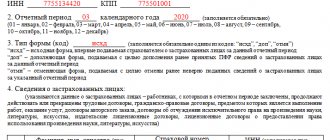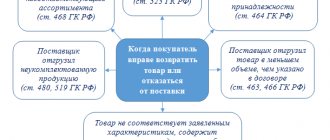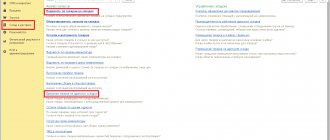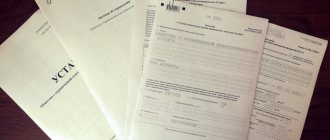The topic of the need to exercise due diligence when choosing a counterparty has been actively discussed by the tax authorities for many years, but recently the Federal Tax Service has been addressing it more and more often, issuing various letters and explanations.
The phrase “counterparty report” appears more and more often. The question about the status of this report is “in the air”: when should it be submitted, in what form, is it even required to be submitted to the tax office? For more information on how to prepare a report on a counterparty and when to submit it, read our article.
The rhetoric of the Federal Tax Service regarding due diligence is changing markedly. As an example, let us cite two excerpts from tax documents on this topic in 2012 and 2021. It is obvious that the company’s burden of responsibility for choosing a counterparty has increased.
year 2012:
The Federal Tax Service of Russia recommends
taxpayers to check the reality of the activities of persons with whom transactions are carried out or planned to be carried out.
2018:
In case of engaging a counterparty to perform work or provide services, the organization must
have information and primary documents about persons performing work or providing services (qualifications, schedule and working conditions, passport details, etc.).
The counterparty has lost its cover in the form of a trade secret
Everything goes to the point that when choosing a counterparty, you should know more about him than his own mother. The mother does not need to know everything, but you need to know everything about the counterparty. Moreover, in recent years there has been little left of the concept of a trade secret. Since July 2017, in accordance with the changes made to Article 102 of the Tax Code of the Russian Federation, the classification of secrecy has been removed from a significant part of the information provided by taxpayers to the Federal Tax Service.
The counterparty cannot hide behind a trade secret in relation to the following information:
- contained in the constituent documents of a legal entity,
- confirming the fact of making entries about a legal entity or individual entrepreneur in the relevant state registers,
- giving the right to carry out entrepreneurial activities,
- on violations of the legislation of the Russian Federation and prosecution for such violations,
- about persons who have the right to act without a power of attorney on behalf of a legal entity.
- data on the average number of employees,
- data on the amounts of taxes and fees paid by the organization,
- data on the amounts of arrears and debts on penalties, fines,
- data on the amounts of income and expenses based on the materials of the accounting (financial) statements.
One of the reasons for disclosing data about taxpayers, according to official statements by the Federal Tax Service, is precisely transparency for potential partners. Lifting the tax secrecy regime on some information about taxpayers gives companies the opportunity to get to know a potential partner more and assess risks at the stage of their selection.
Section Program Data
Program Data section is filled out only for contractors included in the database.
Program Data section displays information about this counterparty entered into the program:
- Name,
- TIN, KPP, OGRN,
- Legal address,
- Actual address,
- Mailing address,
- Contact faces,
- Bank accounts,
- Agreements,
- Telephone,
- email,
- Group of counterparties,
- A comment.
Where to get information about the counterparty. Recommendations from the Federal Tax Service
To protect yourself from entering into transactions with unscrupulous business partners, the Federal Tax Service recommends conducting an independent audit in several areas.
Sources of information about the counterparty:
- electronic services of the Federal Tax Service and other official resources, including various tax services, data from the State Registration Bulletin, database of the bailiff service, etc.
- data from open sources, including those posted in the media and on the Internet, for example, on the company’s official website, on its pages in social networks, on review sites, etc.
- if there are subscriptions, use various databases to check the counterparty, for example “SPARK”, etc.
- The counterparty's address must be real. To check it, you need not to be lazy and go to the specified address. You must be sure that company officials are where they are officially stated to be.
- documents confirming the right of the counterparty to carry out the declared type of activity (licenses, certificates), powers of the official signing the agreement, and primary accounting documents (internal orders, protocols on the election of the head of the organization, powers of attorney). As well as documents that allow you to evaluate the resources of the counterparty, that is, its production capacity, personnel, etc. You must be sure that the counterparty has enough resources to implement the contract. These documents must be requested from the potential counterparty. Remember, the information listed above is not a trade secret of the company.
Section Financial analysis
The Financial Analysis section provides an analysis of the enterprise according to four criteria:
- Bankruptcy risk assessment.
- Creditworthiness.
- Return on assets.
- Sales profitability.
Click the Show calculation to get a detailed calculation of the indicator.
Bankruptcy risk assessment
The degree of risk of bankruptcy of the counterparty is assessed using the Altman formulas . Depending on the range of values in which the calculated Altman index Z , the program assesses the probability of the risk of bankruptcy of the counterparty:
- If the Altman index is less than or equal to 1.1, then the probability of bankruptcy is high.
- If the Altman index is less than 2.6 but more than 1.1, then the likelihood of bankruptcy cannot be ruled out.
- If the Altman index is not less than 2.6, then the probability of bankruptcy is low.
Creditworthiness
To assess the creditworthiness of the counterparty, an analysis of reporting is used according to the methodology approved by the Sberbank of Russia Committee for Providing Loans and Investments dated June 30, 2006 N 285-5-r.
Based on the reporting data, financial ratios and profitability are determined, and the Credit Score is calculated using a special formula. Depending on the range of values in which the calculated indicator S falls, the program evaluates the creditworthiness of the counterparty:
- If the Credit Index is less than or equal to 1.25, then the organization is creditworthy.
- If the Credit Index is less than or equal to 2.35, but more than 1.25, then lending to an organization requires a balanced approach.
- If the Creditworthiness Index is greater than 2.35, then lending is associated with risk.
Return on assets
Return on assets is an indicator of an organization's ability to effectively generate profits.
Return on assets is calculated using the formula:
The calculated indicator is compared with the industry average. Industry data for comparison is determined from the OKVED .
Return on sales
One of the most important indicators is Return on Sales , which reflects the net sales income of the organization. Return on sales is calculated using the formula:
The calculated indicator is compared with the industry average. Industry data for comparison is determined from the OKVED .
Profitability below 90% of the industry average profitability is one of the criteria for assigning an on-site tax audit!
A comprehensive approach to due diligence
The Federal Tax Service recommends taking screenshots of pages from the Internet with information about the counterparty, saving these screenshots, and also printing them. However, you need to know that if the fact of execution of the transaction is not confirmed, a printout from the site will not be considered significant evidence when tax authorities assess the legality of including income tax expenses in the taxable base or applying VAT deductions. An integrated approach is required to exercise due diligence when choosing a counterparty. It is part of this comprehensive approach that the counterparty report is.
How to deliver work to select a counterparty:
- Develop a document on the procedure for working with counterparties.
- Create internal regulations on due diligence and assign a responsible employee to this area.
- Collect information about the counterparty.
- Request a package of documents from a potential counterparty.
- Prepare a counterparty report demonstrating due diligence exercised.
What a counterparty report may include:
- Address, telephone and email of the organization, names of contact persons;
- Names of founders, presence of affiliated structures;
- Extracts from the Unified State Register of Individual Entrepreneurs, Unified State Register of Legal Entities, Rosstat;
- Financial indicators;
- Year the company was founded;
- The number of employees;
- Participation in tenders, availability of government contracts;
- Litigation.
Section Accounting statements
The section shows the financial statements of Russian organizations for three years according to the Rosstat database. However, there may be a delay in updating this information in the report. The data should first appear in the public domain of Rosstat, then in the next update of the program the current year will be updated to build an analysis of reporting in the counterparty Dossier .
You can view the counterparty’s financial statements consisting of:
- Balance sheet. PDF
- Gains and losses report. PDF
- Statement of changes in equity. PDF
- Cash flow statement. PDF
- Calculation of net asset value. PDF
Why do you need a counterparty audit and report?
- For the safety of the company. When choosing a partner, you must be confident in his reliability and that his obligations will be fulfilled.
- To check the Federal Tax Service. A report on the counterparty must be presented to the tax authorities during the audit or upon request.
- For tax deductions. If the Federal Tax Service manages to prove that the company did not exercise due diligence when choosing a counterparty, it will be accused of receiving an unjustified tax benefit and additional taxes will be charged: input VAT, which was accepted for reimbursement from the budget, and income tax.
Formation of a dossier
The Counterparty Dossier report can be generated by:
- counterparties included in the database;
- counterparties that are not in the database.
By counterparties included in the database
For counterparties entered into the database, a dossier is created directly from the counterparty card using the Dossier .
This is convenient to do when you need to assess whether it makes sense to continue relations with a counterparty that is in the Counterparties directory. The report will help you collect all the necessary information for this.
For counterparties that are not in the database
Information on a counterparty can be obtained without entering it into the database by entering the TIN or Name line:
- Section Sales - Settlements with counterparties - Dossier of the counterparty. PDF
- Section Purchases - Settlements with counterparties - Dossier of the counterparty. PDF
This method is suitable for new counterparties that are not yet in the database. Directly from the report, using the Add to directory , you can add a new counterparty to the Counterparties directory.
Do I need to submit a report on the counterparty to the tax office?
The entire regulatory framework related to the topic of due diligence when choosing a counterparty focuses on the fact that the taxpayer must independently conduct an audit of a potential partner and, if necessary, prove the fact of the audit. At present, there are no documents establishing the obligation of managers or officials responsible for maintaining accounting and tax records to send to the Federal Tax Service a report on the counterparty confirming that the counterparty has been verified for good faith. Instructions on this topic, coming from the Federal Tax Service, prescribe in more detail the algorithms for exercising due diligence, sources of information about the counterparty, however, for now, reporting on the work done to verify the counterparty is provided to the Federal Tax Service upon its request, and not systematically, on time and without fail.
Reporting analysis section
The Reporting Analysis section displays summary indicators from the counterparty’s financial statements:
- Sales.
- Profit.
- Money.
- Materials, goods, semi-finished products (stocks).
- Buildings, equipment, vehicles, land (OS).
- Advances issued, debts of counterparties.
- Advances received, debts to suppliers.
- Received credits and loans.
- Net assets.
This information is very clear and understandable even to those users who are not accounting specialists.









